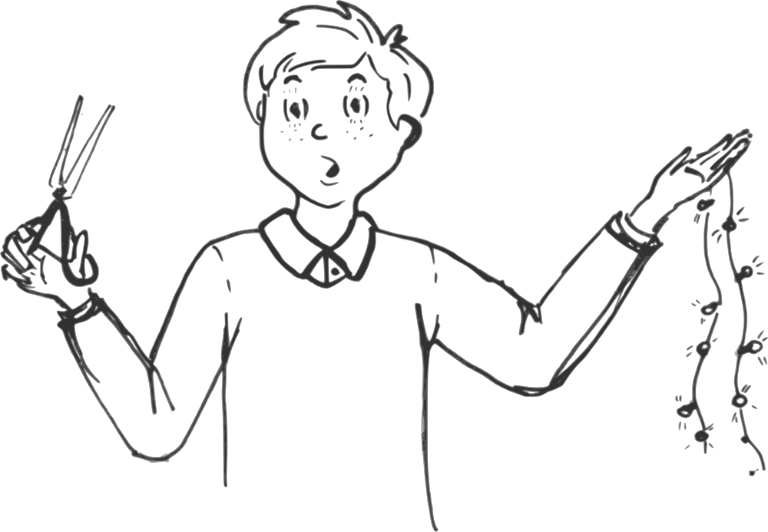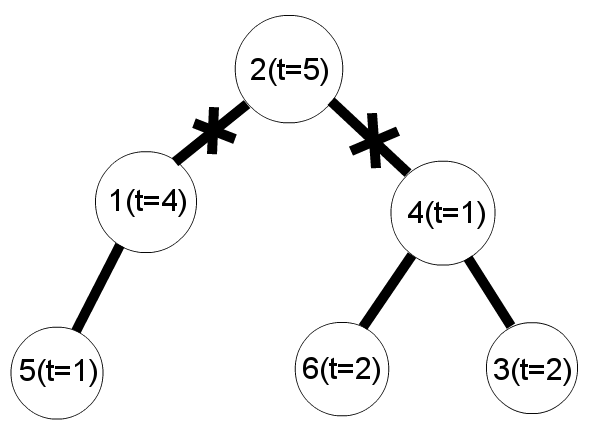codeforces 767 c Garland(dfs)
2017-02-19 19:53
621 查看
C. Garland
time limit per test
2 seconds
memory limit per test
256 megabytes
input
standard input
output
standard output
Once at New Year Dima had a dream in which he was presented a fairy garland. A garland is a set of lamps, some pairs of which are connected by wires. Dima remembered that each two lamps in the garland were connected directly or indirectly via some wires.
Furthermore, the number of wires was exactly one less than the number of lamps.
There was something unusual about the garland. Each lamp had its own brightness which depended on the temperature of the lamp. Temperatures could be positive, negative or zero. Dima has two friends, so he decided to share the garland with them. He wants
to cut two different wires so that the garland breaks up into three parts. Each part of the garland should shine equally, i. e. the sums of lamps' temperatures should be equal in each of the parts. Of course, each of the parts should be non-empty, i. e. each
part should contain at least one lamp.

Help Dima to find a suitable way to cut the garland, or determine that this is impossible.
While examining the garland, Dima lifted it up holding by one of the lamps. Thus, each of the lamps, except the one he is holding by, is now hanging on some wire. So, you should print two lamp ids as the answer which denote that Dima should cut the wires
these lamps are hanging on. Of course, the lamp Dima is holding the garland by can't be included in the answer.
Input
The first line contains single integer n (3 ≤ n ≤ 106) — the number of lamps in the garland.
Then n lines follow. The
i-th of them contain the information about the
i-th lamp: the number lamp ai, it is hanging on (and
0, if is there is no such lamp), and its temperature
ti ( - 100 ≤ ti ≤ 100). The lamps are numbered from
1 to n.
Output
If there is no solution, print -1.
Otherwise print two integers — the indexes of the lamps which mean Dima should cut the wires they are hanging on. If there are multiple answers, print any of them.
Examples
Input
Output
Input
Output
Note
The garland and cuts scheme for the first example:

解题思路:
统计每棵子树的加和,然后dfs每个节点,查看这些子树是否所有节点总和sum/3的倍数为什么是倍数而不是sum/3呢,因为有可能出现一个节点所在子树的和是sum/3,而它父亲节点只有这一个儿子,且这个父亲节点的权值是sum/3,也就是说父亲节点所在子树的和是2*sum/3,这样的情况明显是可以分割的,如果我们只是检查是否是sum/3,这种情况可能就漏掉了.
代码:
#include <bits/stdc++.h>
using namespace std;
const int maxn=1e6+5;
int temp[maxn];
int a[maxn];
vector<int> edg[maxn];
int vis[maxn];
int an[11];
int top;
int xx;
int k;
int dfs2(int a, int b)
{
int tt=0;
for(int i=0; i<(int) edg[a].size(); i++)
{
if(edg[a][i]!=b)
{
tt+=dfs2(edg[a][i], a);
temp[a]+=temp[edg[a][i]];
}
}
if(k)
{
if(temp[a]== (tt+1)*k)vis[a]=++tt;
}
return tt;
}
int main()
{
int n;
cin>>n;
int i;
int root;
top=0;
int sum=0;
for(i=1; i<=n; i++)
{
scanf("%d %d", &a[i], &temp[i]);
sum+=temp[i];
if(a[i]==0)root=i;
edg[a[i]].push_back(i);
edg[i].push_back(a[i]);
}
/* for(i=1; i<=n; i++)
{
for(int j=0; j<(int)edg[i].size(); j++)
{
printf("%d ", edg[i][j]);
}
printf("\n");
}*/
xx=0;
// printf("%d\n", root);
edg[0].push_back(0);
if(sum%3!=0)
{
return 0*printf("-1\n");
}
k=sum/3;
int ans=dfs2(root, 0);
if(ans<3)return 0*printf("-1\n");
// printf("%d\n", sum);
int j=2;
for(i=1; i<=n; i++)
{
if(vis[i]==1 || vis[i]==2){printf("%d", i);j--;
if(j)printf(" ");
else break;
}
}
}
time limit per test
2 seconds
memory limit per test
256 megabytes
input
standard input
output
standard output
Once at New Year Dima had a dream in which he was presented a fairy garland. A garland is a set of lamps, some pairs of which are connected by wires. Dima remembered that each two lamps in the garland were connected directly or indirectly via some wires.
Furthermore, the number of wires was exactly one less than the number of lamps.
There was something unusual about the garland. Each lamp had its own brightness which depended on the temperature of the lamp. Temperatures could be positive, negative or zero. Dima has two friends, so he decided to share the garland with them. He wants
to cut two different wires so that the garland breaks up into three parts. Each part of the garland should shine equally, i. e. the sums of lamps' temperatures should be equal in each of the parts. Of course, each of the parts should be non-empty, i. e. each
part should contain at least one lamp.

Help Dima to find a suitable way to cut the garland, or determine that this is impossible.
While examining the garland, Dima lifted it up holding by one of the lamps. Thus, each of the lamps, except the one he is holding by, is now hanging on some wire. So, you should print two lamp ids as the answer which denote that Dima should cut the wires
these lamps are hanging on. Of course, the lamp Dima is holding the garland by can't be included in the answer.
Input
The first line contains single integer n (3 ≤ n ≤ 106) — the number of lamps in the garland.
Then n lines follow. The
i-th of them contain the information about the
i-th lamp: the number lamp ai, it is hanging on (and
0, if is there is no such lamp), and its temperature
ti ( - 100 ≤ ti ≤ 100). The lamps are numbered from
1 to n.
Output
If there is no solution, print -1.
Otherwise print two integers — the indexes of the lamps which mean Dima should cut the wires they are hanging on. If there are multiple answers, print any of them.
Examples
Input
6 2 4 0 5 4 2 2 1 1 1 4 2
Output
1 4
Input
6 2 4 0 6 4 2 2 1 1 1 4 2
Output
-1
Note
The garland and cuts scheme for the first example:

解题思路:
统计每棵子树的加和,然后dfs每个节点,查看这些子树是否所有节点总和sum/3的倍数为什么是倍数而不是sum/3呢,因为有可能出现一个节点所在子树的和是sum/3,而它父亲节点只有这一个儿子,且这个父亲节点的权值是sum/3,也就是说父亲节点所在子树的和是2*sum/3,这样的情况明显是可以分割的,如果我们只是检查是否是sum/3,这种情况可能就漏掉了.
代码:
#include <bits/stdc++.h>
using namespace std;
const int maxn=1e6+5;
int temp[maxn];
int a[maxn];
vector<int> edg[maxn];
int vis[maxn];
int an[11];
int top;
int xx;
int k;
int dfs2(int a, int b)
{
int tt=0;
for(int i=0; i<(int) edg[a].size(); i++)
{
if(edg[a][i]!=b)
{
tt+=dfs2(edg[a][i], a);
temp[a]+=temp[edg[a][i]];
}
}
if(k)
{
if(temp[a]== (tt+1)*k)vis[a]=++tt;
}
return tt;
}
int main()
{
int n;
cin>>n;
int i;
int root;
top=0;
int sum=0;
for(i=1; i<=n; i++)
{
scanf("%d %d", &a[i], &temp[i]);
sum+=temp[i];
if(a[i]==0)root=i;
edg[a[i]].push_back(i);
edg[i].push_back(a[i]);
}
/* for(i=1; i<=n; i++)
{
for(int j=0; j<(int)edg[i].size(); j++)
{
printf("%d ", edg[i][j]);
}
printf("\n");
}*/
xx=0;
// printf("%d\n", root);
edg[0].push_back(0);
if(sum%3!=0)
{
return 0*printf("-1\n");
}
k=sum/3;
int ans=dfs2(root, 0);
if(ans<3)return 0*printf("-1\n");
// printf("%d\n", sum);
int j=2;
for(i=1; i<=n; i++)
{
if(vis[i]==1 || vis[i]==2){printf("%d", i);j--;
if(j)printf(" ");
else break;
}
}
}
相关文章推荐
- 【dfs】CodeForces - 767C Garland
- F - Garland CodeForces - 767C(dfs)
- codeforces-510B-Fox And Two Dots【DFS】
- codeforces 596E Wilbur and Strings(DFS)
- Codeforces 525D Arthur and Walls 【DFS】
- Codeforces 601D Acyclic Organic Compounds(dfs+字典树合并)
- [LCT维护最小生成树 || CDQ分治 || 线段树 并查集 dfs树] Codeforces 603E #334 (Div. 1) E. Pastoral Oddities
- Codeforces 337D Book of Evil 【树,dfs】
- Codeforces 27B - Tournament (dfs)
- CodeForces 510B Fox And Two Dots(DFS)
- Codeforces Good Bye 2015 B. New Year and Old Property (DFS)
- Codeforces 839C Journey(dfs+概率)
- CodeForces 384E Propagating tree (dfs序)
- Codeforces 598D Igor In the Museum (dfs)
- Codeforces 557D - Vitaly and Cycle (DFS染色)
- Codeforces 767 B The Queue
- Codeforces 842C Ilya And The Tree【Dfs】
- codeforces 366D 求1-n点最大区间长度 枚举区间左端+二分区间右端dfs判可行
- codeforces_679B. Bear and Tower of Cubes(贪心+二分+dfs)
- CodeForces 198B Jumping on Walls(dfs)
